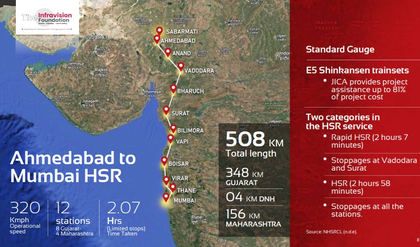High Speed Rail next growth multiplier with potential Rs 12 lakh crore investment: Report
By IANS | Updated: August 19, 2025 21:50 IST2025-08-19T21:44:27+5:302025-08-19T21:50:13+5:30
New Delhi, Aug 19 The High Speed Rail (HSR) is not just about speed but about reimagining India’s ...

High Speed Rail next growth multiplier with potential Rs 12 lakh crore investment: Report
New Delhi, Aug 19 The High Speed Rail (HSR) is not just about speed but about reimagining India’s mobility and economic geography for ‘Viksit Bharat’ at 2047, with a potential investment of Rs 12 lakh crore, a report showed on Tuesday.
Making HSR the locomotive of a new era of development in the country was the big idea at a high-level roundtable hosted by The Infravision Foundation (TIF), in collaboration with the Confederation of Indian Industries’ Rail Transportation and Equipment Division (CII-RTED).
A potential investment of Rs 12 lakh crore will act as a multi-year economic stimulus, creating substantial secondary and tertiary benefits as demand materialises and spending is phased across several years, according to the report.
Every kilometre of HSR provides nearly five times the capacity of conventional rail when utilisation exceeds 90 per cent, while also cutting dependence on fossil fuels and significantly reducing travel time.
HSR allows access to travel for intermediate towns not served by air travel, eases congestion, enables indigenisation, boosts economic competitiveness, and ensures sustainable mobility in a rapidly urbanised country.
With India aiming to become a developed economy by 2047, HSR is no longer a luxury but a necessity, the report noted.
The event marked the release and discussion of the TIF’s new research paper, "The Case for Developing High-Speed Rail Corridors in India", authored by Dr. Ramakrishnan T.S., which presents a compelling case for advancing HSR as a transformative mode of intercity transport in India and connecting it to the unified multi-model urban transport system.
The study recommends prioritising four key HSR corridors between 2025 and 2035: Delhi-Sonipat-Panipat-Karnal-Ambala-Chandigarh-Ludhiana-Jalandhar (566 km); Delhi-Rewari-Jaipur-Ajmer-Jodhpur-Pali/Beenja-Palanpur-Mehsana-GandhiNagar-Ahmedabad (876 km); Delhi-Agra-Lucknow-Ayodhya-Varanasi-Patna-Kolkata (1,670 km); and Mumbai-Navi Mumbai-Pune-Satara-Kolhapur-Belagavi-Dharwad-Davengere-Tumkuru-Bengaluru-Tirupati-Chennai (1,366 km).
Participants at the roundtable noted that much like the Rajdhani Express when it was first introduced in 1969, HSR may initially appear exclusive, but in time will prove to be indispensable for modern, urbanising India, especially with countries such as Japan already advancing towards 500 kmph trains.
A strong consensus emerged that state governments must be brought in from the very beginning as co-owners and financiers of corridors and stations rather than leaving HSR solely to the Union government.
As TIF Founder and Managing Trustee Vinayak Chatterjee said, "a country aspiring to be the third largest economy in the world must learn to travel in speed and comfort".
"Developing HSR should be a national priority," added TIF CEO Jagan Shah.
The discussion also emphasised the importance of indigenisation. India’s success in building metro and RRTS systems was cited as a precedent for creating a domestic HSR ecosystem, reducing reliance on imports, and making projects more affordable.
Participants called for phased demonstration projects at 250 kmph on shorter corridors to build confidence and prove end-to-end domestic capability before scaling further.
The event reinforced that HSR is not just about speed but about reimagining India’s mobility and economic geography for Viksit Bharat 2047.
Disclaimer: This post has been auto-published from an agency feed without any modifications to the text and has not been reviewed by an editor
Open in app